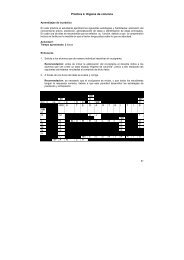Cálculo Diferencial e Integral II - Colegio de Bachilleres del Estado ...
Cálculo Diferencial e Integral II - Colegio de Bachilleres del Estado ...
Cálculo Diferencial e Integral II - Colegio de Bachilleres del Estado ...
You also want an ePaper? Increase the reach of your titles
YUMPU automatically turns print PDFs into web optimized ePapers that Google loves.
Teorema fundamental <strong>de</strong>l cálculo y las aplicaciones <strong>de</strong> la integral <strong>de</strong>finida<br />
Solución: En la Figura 3.6 se muestran los dibujos <strong>de</strong> cada región.<br />
a) Esta región es un rectángulo <strong>de</strong> alto 4 y ancho 2.<br />
3<br />
∫ 4dx<br />
= b×<br />
h = 4(<br />
2)<br />
= 8.<br />
1<br />
b) Esta región es un trapecio <strong>de</strong> alto 3 y bases paralelas <strong>de</strong> longitu<strong>de</strong>s 2 y 5.<br />
1<br />
La fórmula <strong>de</strong>l área <strong>de</strong> un trapecio es ( 1 2).<br />
2<br />
b b h +<br />
3 1<br />
1<br />
21<br />
∫ ( x + 2)<br />
dx = h(<br />
b1<br />
+ b2)<br />
= ( 3)(<br />
2 + 5)<br />
= .<br />
0 2<br />
2<br />
2<br />
c) Esta región es un semicírculo <strong>de</strong> radio 2. La fórmula <strong>de</strong>l área <strong>de</strong> un<br />
1 2<br />
semicírculo es π r<br />
2<br />
2<br />
2 1 2.<br />
1 2<br />
∫ 4 − x dx = π r = π ( 2 ) = 2π<br />
.<br />
−2<br />
2 2<br />
y = 4y<br />
9<br />
8<br />
7<br />
6<br />
5<br />
4<br />
3<br />
2<br />
1<br />
x<br />
1 2 3 4 5 6 7 8 9<br />
Como ya mencionamos anteriormente, cada vez que quieras calcular un área<br />
mediante una integral <strong>de</strong>finida, no es necesario hacer este tipo <strong>de</strong> procedimientos,<br />
basta con aplicar algunas <strong>de</strong> las técnicas <strong>de</strong> integración directa <strong>de</strong> la integral<br />
<strong>de</strong>finida.<br />
EJERCICIO 1 INDIVIDUAL Evalúa la integral <strong>de</strong>finida <strong>de</strong> la función algebraica. Emplea un<br />
instrumento graficador para verificar tu resultado.<br />
1. ∫ 1<br />
0 2xdx<br />
0<br />
2. ∫ ( x − 2)<br />
dx<br />
−1<br />
3. ∫ 7<br />
2 3dv<br />
1<br />
2<br />
4. ∫ ( t<br />
−1<br />
− 2)<br />
dt<br />
5.<br />
3 1<br />
3 v dv<br />
∫−3 3<br />
6. ∫ 2x − 3 dx<br />
0<br />
y<br />
y = x+2; 0.000000

















